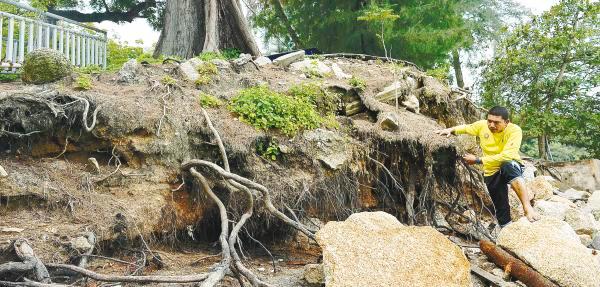PETALING JAYA: Environmental health experts are calling on the government to urgently implement sustainable coastal management practices amid growing concerns over the escalating impact of coastal erosion.
Malaysian Association of Environmental Health secretary Rudiaswady Abdul Rahim said coastal erosion has emerged as a pressing environmental challenge in several regions.
“As coastal areas bear (the brunt) of waves, tides and storms, the gradual loss of land and degradation of ecosystems has captured the attention of scientists, policymakers and communities alike,” he said.
The National Coastal Vulnerability Index (NCVI) introduced under the Second National Coastal Zone Physical Plan revealed that 425km of Malaysia’s coastline was affected by erosion in 2022.
It said 41% of geographical regions, including major areas in Selangor, were assessed at “very high” and “high” vulnerability levels.
Rudiaswady said a detailed breakdown of coastline erosion was released in 2015 by the Department of Irrigation and Drainage.
“Malaysia has a coastline of 8,840km, with 1,347.6km experiencing erosion and 431.3km facing critical and significant damage.
“In East Malaysia, Sabah has the most extensive coastline at 3752.9km, with 429.3km experiencing erosion, and 82.1km facing critical and significant damage.”
He said in Sarawak, 492.5km of its 1,234.1km coastline is experiencing erosion and 163.4km is facing “critical and significant” damage, adding that in the Peninsula, Selangor’s coastline spans 492.1km, with 74.6km affected by erosion, of which 23.4km has been significantly damaged.
“Johor has a coastline of 813.6km, with 64.7km experiencing erosion and 38.1km categorised as undergoing critical and significant erosion, which is the highest for the Peninsula.”
Given that the detailed breakdown was collated eight years ago, Rudiaswady said: “We lack insights into the current state of erosion (impact). But one thing is sure, it is very worrying that we are potentially losing our beautiful beaches.”
Rudiaswady urged the government to carry out a thorough survey of coastline erosion and implement a comprehensive approach that combines nature-based solutions, hybrid strategies, early warning systems and investments in nature-based infrastructure.
In supporting his call, Environmental Management and Research Association vice-president and environmental health activist Dr Subramaniam Karuppannan stressed the importance of swift government action to address erosion, rising sea levels and threats to marine ecosystems.
He said coastal erosion is primarily influenced by a combination of natural processes such as wave and tidal action, and human activities.
“Construction of structures like dams, jetties and seawalls, and unregulated mining and sand extraction for construction disrupts natural sediment (bases).
“Land subsidence, often caused by human activities such as groundwater extraction or oil and gas exploration can contribute to sea level rise and exacerbate coastal erosion.”
Subramaniam said understanding the complex interplay of these factors is crucial for developing effective strategies to mitigate coastal erosion.
“Coastal management practices, sustainable development and climate change mitigation efforts are essential components of addressing the challenges posed by coastal erosion.
“The unveiling of the NCVI underscored the challenges faced by coastal areas in Malaysia, particularly from rising sea levels and extreme weather events.”
While highlighting the transboundary nature of environmental challenges, Subramaniam stressed the importance of regional collaboration to share best practices and resources.
“Advanced technologies, including remote sensing and Geographic Information Systems are called upon for effective monitoring and management of coastal erosion risks. Amid the urgent need for action, the role of community engagement in developing effective coastal management plans is critical.”









